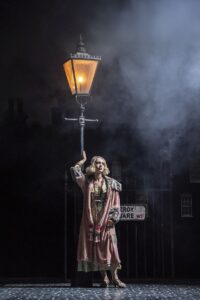
Midnight Bell (1929) is the fourth of thirteen novels written by Patrick Hamilton. Later published as part of a trilogy entitled 20,000 Streets Under the Sky, the piece is largely an autobiographical work drawing on his experiences working in a pub in central London, where he witnessed the social influences on working class lives, and where he was to become besotted with a local prostitute. Best known for his stage plays Gaslight and Rope, later made into successful films, the latter by Hitchcock, Hamilton died in his fifties from cirrhosis of the liver after a life of alcoholism.
It is the darkness of Hamilton’s inner life that suffuses this re-telling by Matthew Bourne. All the trappings we have come to associate with his productions – immaculate staging, the attention to detail in the movement and appearance of the protagonists, the careful timbre of an original score, are all there for the savouring. But the piece’s focus on the dysfunctional nature of its characters, coupled with its placement in the dimly-lit bar rooms and streets of 1930’s London make for an emotionally sad presentation. While remaining true to its creative source, the piece feels tethered by it. As the penultimate song What Is This Thing Called Love echoes out into the auditorium, we are left in no doubt that none of the figures before us have experienced it.

Drawing on six of Hamilton’s novels, Bourne has placed the pub The Midnight Bell as a hub for Hamilton’s patchwork of characters, a collection of lonely hearts without the wherewithal to connect meaningfully. It is here that they find solace in drink, finding transient comfort from their fragile associations. Into the mix, Bourne has added a homosexual relationship, with all the paranoia and furtiveness that would have accompanied such a pairing in 1930’s Britain. Liam Mower as Albert and Andy Monaghan as Frank, offer impassioned tentative then released moves in their portrayal.
Constructed with short sequences from each life, the dancing is interspersed with lip-synched thirties-style songs that suffuse the ballet with sarcastic sentimentality. Bourne’s genius for moving multiple players in and out of the action, like a sea anemone effortlessly pulsing its tentacles, remains an achievement easily taken for granted.

Bob the barman (Dominic North) is hopelessly in love with Jenny Maple a young prostitute played by Ashley Shaw – the disconnect between them evident in a memorable pas-de-deux involving a bed. Glenn Graham brings a sly style to the ‘cad’, Ernest Ralph Gorse while Danny Reubens takes us to a much darker place with his portrayal of George Harvey Bone, who forces himself on the woman who eludes him. Michela Meazza as spinster Miss Roach carries herself with a stiffness that belies her loneliness. All retain their signature characterisations whether stationary or in motion.
Set and costume designer Lez Brotherston, lighting designer Paule Constable and sound designer Paul Groothuis form the dream production team. With a cast of ten in constant flow to consider, Brotherston’s staging had to remain at its most fluid for the production to work. With a cascade of suspended sash windows and period city signs hanging before a beautifully realised London roofscape, elements of the Midnight Bell’s interior and exterior – the bar, tables and seating, swing doors, windows and memorable hanging sign were rolled, slid or swung into place with seeming ease. Constable’s delightfully romantic lighting – the backlit window scape was a delight in itself – the intimate highlights on the pub’s clientele, or on the seedy next-door hotel’s bedrooms, helped the audience focus on the sense that the lives unfolding before them were limited and claustrophobic. Groothuis’s sound effects – the beating of pigeon’s wings, a distant dog’s barking, footsteps on the pavement, all added greatly to the overall atmosphere. Terry Davies’ score resides very much in the minor key throughout, and makes the most of what 1930’s popular song orchestration can offer – happy/sad visions of love, just out of reach.
★★★★☆ Simon Bishop 21.05.2025
Photography credit: Johan Persson


